Uterine Fibroids, types, clinical features, Causes, Diagnosis, treatment and management options
Fibroid is a condition affecting uterine smooth muscle termed leiomyoma, which is considered a benign tumor
It is the most common tumor of the uterus affecting 20-30% of women.
Classification of Uterine Fibroids:
depending on its location 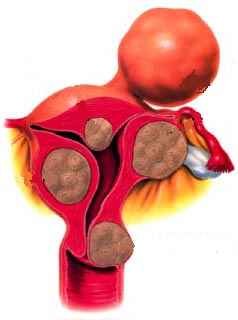
1-Submucous fibroid :The tumor is protruding through the uterine cavity.
2-Intramural fibroid :The tumor is located within the myometrium.
3-Subserosal fibroid :The tumor is located at the outer border of the myometrium.
4-Pedunculated fibroid :The tumor is attached to the outer border of the uterus by a narrow pedicle containing blood vessels.
5-Fibroids can arise as a separate entity away from the uterus in the broad ligament mainly from the embryonic remnant
Pathology of Uterine Fibroids
Macroscopic appearance
Fibroids present as single or multiple circular or irregular masses. They have a false capsule consisting of compressed myometrial tissue by the tumor.
On cross section, the tumor has characteristic whorled arrangement of tissue bundles, and its centre may show different types of degeneration.
Microscopic appearance
Fibroids consist of smooth muscle fibers and fibrous connective tissue.
Types of fibroid degeneration
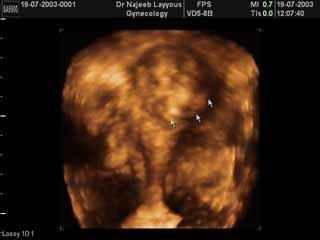 Fibroid Uterus
Fibroid Uterus1-Red degeneration
It follows an acute loss of blood supply to the fibroid during its active growth mainly seen during pregnancy.
Patients present with the sudden onset of abdominal pain,and tenderness localized to the uterus associated with mild pyrexia and leukocytosis.
The symptoms and signs resolve over a few days and surgical intervention is rarely required.
2-Hyaline degeneration
This type of degeneration is caused by the gradual decrease in the blood supply to the fibroid.
It is asymptomatic and can cause central necrosis leaving cystic spaces at the center termed cystic degeneration.
Calcification of a fibroid
This type of change in the fibroid is caused by deposition of calcium in the fibroid and can be detected on the abdominal x-ray in postmenopausal women.
Malignant changes
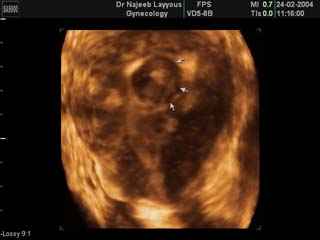 Submucous Fibroid
Submucous FibroidOccurs in 0.1 -0 .5 % of fibroids known as sarcoma, which is characterized by rapidly increasing tumor size.
Clinical features of Uterine Fibroids
The location of the fibroid and size affect the nature of symptoms of this disease.
1- Menstrual disturbance
Fibroid is an important cause of uterine bleeding, mainly menorrhagia or intermenstrual bleeding, mainly in sub mucous type and as thus can present with symptoms of anemia.
2-Pressure symptoms, especially urinary frequency or constipation due to pressure of the growing fibroid on the adjacent structures like the urinary bladder and the rectum.
3-Pain is unusual except in red degeneration of a fibroid
4-Sub- fertility;
Due to mechanical distortion or occlusion of the fallopian tubes and distortion of the endometrial cavity by a sub, mucous fibroid which can prevent implantation of the fertilized ova.
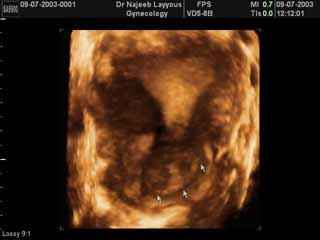 Cervical Fibroid
Cervical Fibroid5-Obstetric complications
In late pregnancy if the fibroid is located in the cervix or the lower uterine segment it can cause fetal abnormal lie or presentation and obstructed labor.
After delivery, there is a risk of postpartum hemorrhage due to inefficient uterine contractions.
Signs of fibroids
Abdominal examination may indicate the presence of a firm mass arising from the pelvis.
On bimanual examination, the mass is felt to be a part of the uterus with some limited mobility.
Predisposing factors for Uterine Fibroids
1-Nulliparity
2-Obesity
3-Family history
4-African racial origin
Differential diagnosis of Uterine Fibroids
1- Ovarian tumor,whether benign or malignant.
2- Adenomyosis.
3- Leiomyosarcoma; patient presents with a history of rapidly enlarging abdominal-pelvic mass and decreased mobility of the uterus. In addition to general signs of cachexia.
Diagnosis of Uterine Fibroids
.1-U/S Mainly vaginal U/S gives accurate information to distinguish a uterine fibroid from an ovarian mass.
Fibroids appear as circular, well-demarcated lesions.
2-Hysteroscopy for diagnosing and treating sub mucous fibroids.
Treatment of Uterine Fibroids
The choice of treatment will be influenced by many factors, e.g. the general health, the age, parity and the desire to have more children in addition to the size and location of the fibroid.
Medical treatment of Uterine Fibroids
Small and asymptomatic fibroids need to follow up by u/s every 6 months. When symptoms appear and treatment is required, medical therapy is ovarian suppression using GNRH agonist.
This type of treatment is effective in shrinking the tumor. When treatment is stopped, ovarian function resumes and fibroids grow back to their previous size.
Surgical treatment of Uterine Fibroids
Cases of sub mucous and intrauterine fibroids can be removed by hysteroscopy.
Other types of a fibroid are removed by abdominal myomectomy or hysterectomy.
1-Myomectomy
Usually done for young women who want to preserve their reproductive function. It is done by Laparoscopy or Laparotomy, especially for large-size fibroids.
2-Hysterectomy; reserved for patients above 40 years who completed their families either by total or subtotal abdominal or vaginal hysterectomy.
GNRH agonist pretreatment over a two-month period can facilitate hysterectomy or myomectomy to reduce the bulk and vascularity of a fibroid prior to surgery.
Indications for surgery for Uterine Fibroids
1-Heavy or prolonged blood loss through the menses.
2-Large size fibroid.
3-Pressure symptoms like urine retention.
4-Possible malignant changes.
Fibroid destruction
1-Myolysis; the idea of this treatment is to cut the blood supply to the fibroid laparoscopically and use laser to cauterize the blood vessels feeding the fibroid.
Disadvantages of this method are that it may be associated with intra abdominal adhesions especially, between uterus and the intestines.
2-Embolization of the uterine artery
This type includes selective block to the uterine artery.
This is the most modern type of treatment done by percutaneous selective catheterization. It is associated with substantial reduction in fibroid size and improvement of menstrual symptoms over the following 6 months.
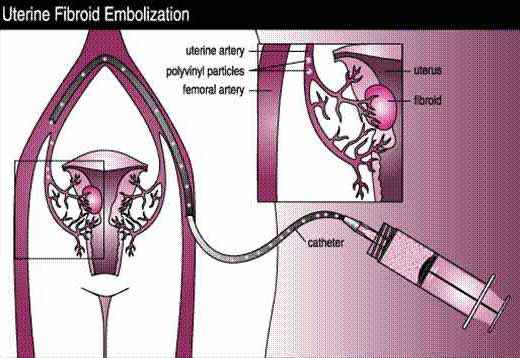
Fibroids in pregnancy
What is the effect of fibroids on fertility and pregnancy??
The presence of fibroids in the female reproductive system negatively affects fertilization and pregnancy as follows:
- Causing a distortion in the shape of the uterus, which affects the ability of sperm to enter the uterus or fallopian tubes, which
reduces the chance of fertilization .
- A change in the lining of the uterus in terms of size and the amount of blood that may reach the endometrium, which may cause difficulty in
the implantation of the fertilized egg or the development of the fetus
-May reduce the efficacy of infertility and fertility treatments
Some expected complications in pregnancy:
a. Repeated miscarriages and preterm birth
B. bleeding in pregnancy
c. Dystocia or obstructed labour
D. Effect on the fetus
Therefore, all women who are trying to conceive have to see their doctor to check whether there are fibroids in order to avoid
complications before or during pregnancy .
Dr Najeeb Layyous F.R.C.O.G
Consultant Obstetrician, Gynecologist and Infertility Specialist







 Pregnancy Due Date Calculator
Pregnancy Due Date Calculator
 Chinese Gender Predictor
Chinese Gender Predictor
 Ovulation Calculator
Ovulation Calculator
 IVF Due Date Calculator
IVF Due Date Calculator
